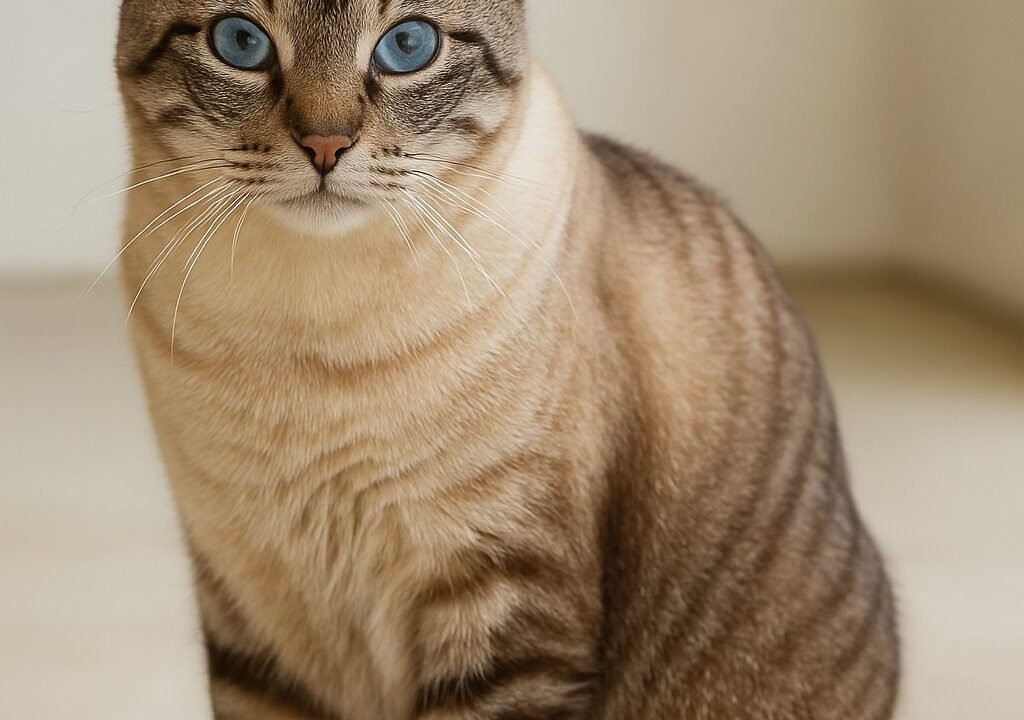Breed Overview
The American Shorthair Siamese Mix is not recognized by major cat associations such as the Cat Fanciers’ Association (CFA) or The International Cat Association (TICA). Instead, it is a hybrid created by crossing the sturdy, adaptable American Shorthair with the elegant, vocal Siamese. This mix blends two distinct feline lineages, producing cats that are versatile, affectionate, and appealing to a wide range of households. Despite its unofficial status, it remains a popular and well-loved choice, often found through shelters, rescues, and mixed-breed adoptions.
Origin and Background of Hybridization
The American Shorthair has roots as one of the oldest cat breeds in the United States, valued for its resilience, hunting skills, and balanced temperament. The Siamese, in contrast, is an ancient breed originating from Thailand (formerly Siam), best known for its striking blue eyes, pointed coat pattern, and strong vocal personality. When bred together, their offspring inherit a balance of physical sturdiness, adaptability, and intelligence.
Why This Mix Exists
Breeders and rescues may intentionally or unintentionally produce this cross. The primary reasons include:
- Balanced Personality: Combining the independence of the American Shorthair with the affectionate and social nature of the Siamese.
- Health Diversity: Hybrid vigor can reduce the risk of breed-specific genetic conditions, although careful monitoring is still essential.
- Appearance Variety: This mix often produces cats with striking coats, unique eye colors, and an appealing blend of features.
- Adaptability: Easier adjustment to both active families and quieter households compared to a pure Siamese.
Physical Characteristics
The American Shorthair Siamese Mix displays a wide range of physical traits depending on which parent breed is more genetically dominant. This variability is part of what makes the mix unique, but certain features are consistently seen.
Size & Build
These cats are typically medium to large in size, weighing between 8–15 pounds. They inherit the muscular and well-balanced body of the American Shorthair, but with a slightly more refined, athletic outline influenced by the Siamese. Their structure allows for both strength and agility, making them active yet sturdy companions.
Coat Type & Colors
The coat is short and low-maintenance, often lying close to the body. Because both parent breeds have distinct coat patterns, mixes may appear in a wide variety of styles, including:
- Pointed patterns (common with Siamese influence, especially with lighter bodies and darker extremities).
- Tabby striping (frequent in American Shorthair genetics).
- Solid colors such as black, white, or gray.
This diversity makes each American Shorthair Siamese Mix visually distinctive.
Head Shape
Head structure varies by genetic dominance. Some cats inherit the rounded, broad face of the American Shorthair, while others display the triangular, wedge-shaped face typical of the Siamese. This influences overall facial expression and muzzle width.
Eyes & Ears
Eye color and shape are among the most striking features of this mix. Cats with stronger Siamese traits often develop blue, almond-shaped eyes, while those leaning toward the American Shorthair side may present with rounder eyes in shades of gold, green, or hazel. Ear size also differs — from the larger, upright Siamese ears to the smaller, rounded Shorthair style.
Expected Lifespan
With proper nutrition, preventive veterinary care, and an indoor lifestyle, the average lifespan ranges from 12 to 16 years. This aligns with the typical longevity of both parent breeds, though some individuals may live even longer with optimal care.
Temperament & Behavior
The American Shorthair Siamese Mix combines the steady, adaptable personality of the American Shorthair with the social, vocal, and intelligent nature of the Siamese. This balance creates a cat that is interactive yet manageable, making it a suitable choice for many households.
Sociability
These cats are generally affectionate and moderately people-oriented. They enjoy spending time with family members and will often seek attention, but they are not as demanding as a pure Siamese. They bond strongly with their owners and tend to follow them around the home without being overly clingy.
Vocalization
While purebred Siamese are known for their constant and loud vocalizations, this mix is usually less vocal. Many individuals “talk” to their owners with softer meows, trills, or chirps. Owners should still expect more communication than with a typical American Shorthair.
Intelligence Level
This hybrid tends to inherit the Siamese’s high intelligence and curiosity. They learn quickly, enjoy interactive toys, and may figure out how to open doors or cabinets. Providing puzzle feeders and rotating enrichment activities helps prevent boredom and unwanted behaviors.
Energy Needs
The mix is active but not excessively hyper. They appreciate daily play sessions, climbing structures, and opportunities to explore. Unlike some high-energy breeds, they also value downtime and are content to rest near their owners after exercise.
Compatibility With Other Pets and Children
The American Shorthair Siamese Mix is typically good with children if introduced properly and treated respectfully. They adapt well to multi-pet households, including homes with other cats or even dogs, provided introductions are gradual and supervised. Their adaptable nature makes them suitable for both busy families and quieter homes.
Health Considerations
Like all mixed-breed cats, the American Shorthair Siamese Mix can inherit health strengths from hybrid vigor as well as genetic risks from each parent breed. Awareness of these potential issues allows owners to provide proper preventive care and improve long-term quality of life.
Genetic Risks From the Siamese Side
- Dental Disease (Periodontal Issues): Siamese cats are prone to gum disease and tooth resorption. Regular dental check-ups and at-home oral care are recommended.
- Progressive Retinal Atrophy (PRA): This inherited eye disorder can lead to gradual vision loss and eventual blindness. Early detection through veterinary ophthalmic exams is essential.
- Respiratory Sensitivity: Cats with Siamese facial features may have narrower nasal passages, making them more susceptible to respiratory infections or breathing difficulties.
Genetic Risks From the American Shorthair Side
- Hypertrophic Cardiomyopathy (HCM): This is a common feline heart condition that can occur in American Shorthairs and may be passed to mixed offspring. Regular heart screenings can aid in early detection.
- Obesity Risk: American Shorthairs are often easygoing and can gain weight quickly if not given proper diet and exercise management. Obesity increases the risk of diabetes, arthritis, and heart disease.
- Polycystic Kidney Disease (PKD): Although less common, PKD has been reported in some American Shorthair lines. Genetic testing and regular bloodwork help monitor kidney health.
General Preventive Care
- Annual Veterinary Check-Ups: Comprehensive physical exams allow early detection of genetic or acquired conditions.
- Vaccination Schedules: Core and lifestyle-based vaccines (rabies, feline viral rhinotracheitis, calicivirus, panleukopenia) should be administered according to veterinary guidelines.
- Parasite Prevention: Year-round flea, tick, and intestinal parasite control helps maintain health and prevents zoonotic transmission to humans.
Grooming & General Care
The American Shorthair Siamese Mix is a low-maintenance cat when it comes to grooming. Their short, dense coat requires only basic care, but consistent attention to hygiene helps prevent health issues.
- Coat Maintenance: These cats shed moderately and typically only need weekly brushing to remove loose hair and reduce hairballs.
- Nail Trimming: Trim claws every 2–3 weeks to prevent overgrowth, snagging, or damage to household items.
- Dental Hygiene: Because this mix can inherit dental sensitivity from the Siamese side, routine tooth brushing with feline-safe toothpaste and professional cleanings as recommended by a veterinarian are strongly advised.
- Ear Checks: Inspect ears weekly for wax buildup, dirt, or signs of infection such as redness or odor. Clean only with veterinarian-approved solutions.
- Bathing: Bathing is rarely required, as cats groom themselves effectively. Baths should only be performed if medically indicated, such as for skin conditions or flea infestations.
Nutrition & Feeding
Proper nutrition is critical for supporting the overall health and longevity of the American Shorthair Siamese Mix. A diet tailored to their needs helps prevent obesity and supports muscle tone, dental health, and energy levels.
- Recommended Diet: Provide a high-quality commercial cat food formulated with animal-based protein as the primary ingredient. Wet or dry food can be used, but wet food supports hydration. Choose balanced formulas that meet AAFCO (Association of American Feed Control Officials) standards.
- Feeding Frequency:
- Kittens: Small, frequent meals (3–4 times daily).
- Adults: Twice daily feeding is recommended to support healthy digestion and portion control.
- Avoiding Obesity: Obesity is a concern, particularly from the American Shorthair lineage. Owners should practice measured feeding instead of free-feeding and monitor body condition regularly using the feline body condition scoring (BCS) system.
- Supplements: Most healthy cats do not require supplementation if fed a balanced diet. However, under veterinary supervision, specific supplements such as omega-3 fatty acids (skin and joint health) or taurine (essential for heart and vision) may be advised.
Exercise & Enrichment
The American Shorthair Siamese Mix requires both physical activity and mental stimulation to remain healthy and well-adjusted. While not as demanding as a pure Siamese, this hybrid is more active than the average American Shorthair.
- Daily Play Sessions: Provide interactive toys such as wand teasers, feather chasers, fetch toys, and laser pointers. Two or more structured play sessions per day help prevent boredom and weight gain.
- Puzzle Feeders: This mix benefits from food-dispensing toys or puzzle feeders, which encourage natural hunting behaviors and keep the cat mentally engaged.
- Climbing & Scratching Opportunities: Install cat trees, climbing shelves, and scratching posts to satisfy their need for vertical space and nail maintenance. Multiple scratching surfaces (carpet, sisal, cardboard) prevent destructive scratching.
- Indoor Lifestyle: To maximize safety and longevity, these cats should remain indoors only. Indoor living protects them from traffic, predators, infectious diseases, and environmental hazards, while still allowing enrichment through toys, window perches, and supervised outdoor enclosures (catios).
Training & Socialization
The American Shorthair Siamese Mix is intelligent and highly trainable when positive methods are used. Early training and consistent socialization support good behavior and prevent common household issues.
- Litter Training: This mix typically adapts quickly to litter box use, provided the box is kept clean and placed in a quiet, accessible area.
- Teaching Boundaries: Redirect unwanted behaviors, such as scratching furniture, by placing scratching posts near high-use areas and rewarding use with praise or treats.
- Positive Reinforcement: Reward-based training methods—using treats, clicker training, or verbal praise—are effective. Avoid punishment, as it can cause fear, stress, and behavioral problems.
- Early Socialization: Exposure to children, other cats, and even well-behaved dogs from a young age encourages adaptability. Supervised introductions and gradual exposure reduce stress and help them develop into confident adult cats.
Suitability as a Family Pet
The American Shorthair Siamese Mix is well-suited to households that want a cat with a balanced personality—affectionate but not overly demanding.
- Balanced Companion: They provide a mix of independence and companionship, making them ideal for families who want interaction without constant attention needs.
- Adaptability: These cats adjust well to apartments or larger homes, provided they have adequate stimulation and enrichment.
- Multi-Pet Households: With proper introductions, they can coexist peacefully with other cats and even dogs. Gradual socialization ensures positive long-term relationships.
- Owner Considerations: Not recommended for individuals who prefer a completely quiet cat, as this mix often inherits at least some vocal tendencies from the Siamese side.
Adoption & Buying Guide
Adopting or purchasing an American Shorthair Siamese Mix requires careful consideration to ensure a healthy and ethically sourced cat.
- Average Cost: In the United States, the price typically ranges from $300 to $800, depending on breeder reputation, location, and whether health testing is included. Adoption fees are usually lower ($75–$200) and often cover vaccinations and spay/neuter surgery.
- Ethical Concerns: Avoid backyard breeders and kitten mills. Choose sources that prioritize the health and welfare of both parent cats and offspring.
Common Owner Mistakes to Avoid
Owning an American Shorthair Siamese Mix comes with specific responsibilities. Avoiding these common mistakes ensures better health and behavior outcomes:
- Ignoring Dental Health: Failure to provide routine dental care increases the risk of periodontal disease, which this mix may inherit from the Siamese side.
- Free-Feeding: Leaving food out at all times promotes obesity, especially in cats with American Shorthair genetics. Portion control is essential.
- Underestimating Enrichment Needs: While not as demanding as a pure Siamese, this mix requires daily play and stimulation. Neglecting enrichment may lead to destructive behavior.
- Delaying Veterinary Checkups: Skipping regular exams increases the risk of late detection of conditions such as HCM, kidney disease, or dental issues. Preventive care is always more effective than treatment after disease progression.
FAQ’s
Do American Shorthair Siamese mixes always have blue eyes?
Not always. While Siamese cats typically pass down striking blue eyes, American Shorthairs can produce green, gold, or hazel shades. Eye color depends on genetic dominance, so mixed kittens may inherit anything from deep blue to vibrant green.
Are they hypoallergenic cats?
No cat breed is truly hypoallergenic. However, this mix tends to produce moderate dander and may trigger fewer allergies than long-haired breeds. Regular grooming, vacuuming, and air purification can help allergy-sensitive households.
How big do American Shorthair Siamese mixes get?
Most fall into the medium size range, weighing 8–12 pounds at maturity. Their muscular frame from the Shorthair side balances with the leaner Siamese physique. Males are generally larger than females.
Do they get along with dogs?
Yes, with proper introductions. Their social and adaptable nature often makes them good companions for cat-friendly dogs. Early exposure and positive reinforcement are key to building harmony in multi-pet homes.
What is their average lifespan compared to pure breeds?
With attentive care, this mix typically lives 12–16 years, which is comparable—or even slightly longer—than many purebred cats. Genetics, nutrition, and preventive healthcare greatly influence longevity.
Do they require special diets?
No special breed-specific diet is required. A balanced, high-protein feline formula works best. Owners should focus on portion control to prevent obesity and consider supplements like taurine or omega-3s if recommended by a veterinarian.
Conclusion
The American Shorthair Siamese mix is a smart, affectionate, and adaptable cat that blends the best traits of both breeds. With low-maintenance grooming, moderate energy, and strong family compatibility, they fit well in many homes. Ensure regular vet care, a balanced diet, and daily enrichment, and this hybrid will thrive as a loyal, long-lived companion.
Here’s where you can find your perfect cat.





